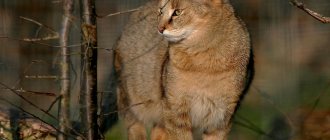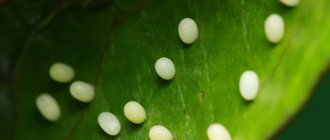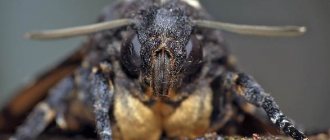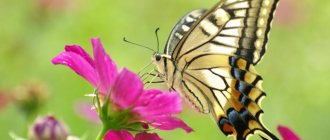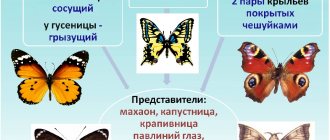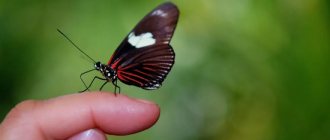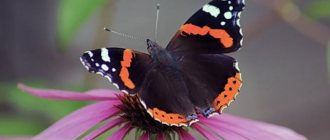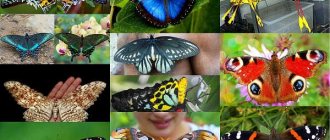Morpho is a genus of diurnal butterflies native to Central and South America. The total number of species is about 80.
The butterflies apparently owe their strange name to the ancient Greeks. Translated from their language, the word morpha means “beautiful.” Indeed, among insects they have practically no equal in their unsurpassed range of shades.
Morpho.
Glass Butterfly (Greta Oto)
The glass butterfly (Greta oto) is found in Central and North America and is known for its long-distance migrations.
It is typically found in Mexico and Colombia, but migrates to Florida in search of food. The butterfly got its name from its transparent wings with brown or black edges. This makes it difficult for predators to detect this butterfly, especially at long distances. In Mexico she is also called Greta Oto. The insect feeds on a common species of flowering plant called Lantana. The glass butterfly is also one of the most transparent living creatures on the planet. If we talk about appearance, the internal and external colors of the wings are strikingly different. The outer colored part of the wings is less attractive compared to the inner one. The tops of the wings are dusty gray with a few blue and orange dots, and the insides look like iridescent soffits. Its unique coloration makes it one of the most beautiful butterflies in the world.
Lemongrass is a long-liver in the world of butterflies
Gonepteryx rhamni, wingspan – 52-60 mm
Lemongrass, or buckthorn, is a rather inconspicuous-looking butterfly from the white butterfly family. Small dots are placed in the center of its wings, and the wings themselves imitate the shape of leaves on a tree. Nature has done its best so that these insects can hide from their enemies!
Males have a richer wing color than females. In the latter, the color of the wings is predominantly greenish-white. The development cycle of one individual takes about a year, which is a rare phenomenon in the world of butterflies. Therefore, lemongrass can safely be called a long-liver.
macroid.ru
Lemongrass lays 1-2 eggs on buckthorn leaves. Then green, smooth, slightly flattened caterpillars appear. Despite their great appetite and fastidiousness, insects do not cause much harm to trees.
How to attract lemongrass. Mostly butterflies feed on the nectar of dandelion, meadow cornflower, thistle, but they will not refuse cultivated plants. It is better to fight weeds that attract lemongrass in your summer cottage.
- How to get rid of weeds - the secrets of “clean” beds
Weed control is the main headache of all summer residents. Let’s figure it out together how to suppress the growth of weeds effectively and easily.
Can you buy dolls?
But it is much more interesting to watch how the winged beauty emerges from the chrysalis. To do this, you can purchase a turnkey kit, which includes:
- Butterfly garden (house for dolls).
- Pupae.
- Growing instructions.
A butterfly pot is a glass container into which pebbles are placed at the bottom and water is poured. Inside there is a stick to which the pupae are attached. It's all covered with breathable fabric.
If all conditions are met, butterflies will appear within 2 weeks. They can fly freely around the apartment. However, remember that other pets and open windows are a direct threat to their existence.
Apollo
Apollo (Parnassius apollo) is an extremely rare species of butterfly. It is found only in parts of Italy, France and Spain and is currently endangered. He has very beautiful shimmering silver wings. The forewings have black spots, and the hindwings have larger red and black spots called "eyespots". The larvae of this butterfly have excellent colors, which help camouflage themselves from predators. Adults use large spots on their wings and a foul-smelling substance to scare away predators.
The red and black spots on the hind wings can vary in size and shape depending on their location on the butterfly's wings. The bright color also fades in the sun, causing the red spot to appear orange in older butterflies. The edges of the wings are slightly transparent, which gives the butterfly additional charm.
Behavior
The tropical morphopeloid butterfly is active during daylight hours. Adults feed on the juice of spoiled fruits, pollen and nectar. They especially like sweet bananas that are starting to rot.
They fly over open forested areas along paths, rivers and lakes. Their zigzag flight is fast and powerful, with females most active in the air around midday. The rapid flapping of the wings resembles blue lights against a background of monotonous greenery.
Natural enemies of these insects include the red-tailed jacamara (Galbula ruficauda) and birds from the flycatcher family (Muscicapidae).
Dragonfly-like
The lamprothera meges butterfly is not very large for a swallowtail. Its wingspan is only 5 cm, but they are equipped with long tails. And in flight, this butterfly resembles a dragonfly, since its front wings are almost devoid of scales and therefore translucent. You can meet this unusual sailboat, like the dragonfly, along the banks of rivers and streams in Southeast Asia.
"Lady with a Train"
Angel Sylphina
This beautiful butterfly is found in some countries of South America: Bolivia, Ecuador and Peru. Like the glass butterfly, the sylphina butterfly (Chorinea sylphina) has mostly transparent wings with black edges. The lower part of the wing has red and white stripes. Sylphina lives only in forests growing at significant altitudes. She prefers not to fly without bright sunlight. Usually these insects fly alone in search of food, but sometimes they gather in groups of several hundred individuals. In the spring, they also migrate to areas more than 300 kilometers away in search of food.
Popular articles Stone casket
This beautiful butterfly can lay up to 150 pink eggs at a time. The caterpillars crawl throughout the plant until each one has its own leaf. When the caterpillars mature, they create a chrysalis from their leaf. Adult butterflies drink flower nectar. The butterfly's lifespan is less than 9 months.
Blueberry - a day butterfly with an unusual color
The diversity of the world's fauna is expanding with thousands of different species of butterflies, both large and small, both bright and dark. Many legends and beliefs are associated with these wonderful insects, for example, in ancient times, the Slavs treated butterflies with respect, because they thought that they were the souls of the dead. But the topic of today’s article will be the blueberry butterfly , a fairly common species among the steppes and tropics.
Reproduction
Morphopeleid butterflies breed all year round. After mating, the female lays one egg at a time on the undersides of the leaves of tropical legume plants. Most often these are Pterocarpus, Lonchocarpus, Andira, Swartzia and Dalbergia.
The caterpillars hatched from the eggs are very thin, reddish-brown in color with yellow or light green spots. They grow quickly and undergo 5 molts before pupation, growing up to 90 mm.
The color of the pupae can be green in a variety of shades. The thorns with which they are attached to the branches upside down are clearly visible in their lower part.
Sailboat Palinur
An attractive daytime butterfly from the tropics is noticeable by the amazing beauty of its wings, the lower part of which has a deep black color, and the upper side shimmers with emerald stripes. The beauty's hind wings are complemented by peculiar teardrop-shaped tails, which give this charming creature an exotic shape and provide additional protection options: she can easily leave them to a grasping predator and ascend upward.
The most interesting color, which makes the emerald swallowtail invisible against the backdrop of green landscapes, allows it to live its short life, which lasts up to 10 days, in absolute peace.
pet
Given the size of these lepidopterans, a large insectarium is required to maintain them. Blue morph butterflies are fed with sugar syrup and fruits, which are pre-cleaned. Feeding is carried out 1-2 times a day.
The biggest problem is maintaining humidity. If conditions are too dry, the butterfly's legs, antennae and wings will break. The optimal temperature for insect life is 23–38 degrees Celsius. In cooler conditions, butterflies become inactive and sleepy. And at a temperature of 15 degrees they generally die.
The average price for such butterflies in Russia is from 3 to 6 thousand rubles.
Description of the species
Morphodidius are butterflies belonging to the genus Morpho, of the Nymphalidae family. Various scientists include 30-60 species of butterflies in the genus. Morphodidius is one of the largest representatives of the group, with a wingspan of 135-160 mm. The outer edge of the front wings has a protrusion, and there are serrations along the entire perimeter.
The color of the wings is a rich blue color with a violet, pearlescent or green tint. When viewed from different angles, the shades of the wings change. The incredible metallic shine and radiance of the butterfly's color is due to the special structure of its scales. The most common form of coloration is an azure blue background with brown edging along the edge of the wings. There are individuals of purple, emerald or blue hue. The reverse side of the wings is brown. Ocellated spots and light bands are scattered across the main background. The protective coloration allows butterflies that spend a lot of time on trees to remain unnoticed. The wings folded behind the back disguise the didius as a dry leaf.
The butterfly's body is divided into 3 main sections: head, chest and abdomen. The eyes are large, protruding, occupying most of the head. The morpho's organs of vision are sensitive to ultraviolet radiation; males notice each other at a considerable distance. The filamentous antennae are dark and serve as olfactory organs. Insects feed using a long proboscis. Two pairs of wings and three pairs of walking-type legs are attached to the thoracic region. The forelimbs are reduced, which is a characteristic feature of representatives of the nymphalidae family.
Sexual dimorphism
In tropical butterflies of the genus Morpho, sexual differences are noticeable. Males are bright blue with a metallic sheen. The wings of females lack a pearlescent sheen; along the edge there is a wide brown stripe, often with white spots. Males are more active, although this quality often turns against them. Butterfly catchers wave blue scarves to attract male morphos.
Popular articles Mosaic “Broken Heart”
Features of the structure of scales
The refraction of light rays on the plates causes a rainbow-colored glow, this optical effect is called iridescence. The blue color is created not by pigmentation, but by the reflection of light from the pyramidal scales. The lower part of the scales has a color that does not transmit light, which gives additional brightness. The beam is reflected from the outer and inner surfaces of the scale, creating two reflections that reinforce each other.
So colorful
At different angles of incident light, the wings of this butterfly can be bright blue, cyan and even green. This effect is achieved thanks to lens-shaped scales that cover the entire surface. The upper part is transparent, and the lower part contains the pigment melanin. Light passes through the transparent part, and then is reflected from the colored part and refracted many times (interference effect). This is how the metallic shine of a butterfly’s wings and its unusually beautiful color arise. And if an insect folds them, it can simply disappear from view, and then appear out of nowhere.
Butterflies and people
In nature, this species has no economic significance. Local Indians have long used butterfly wings to decorate masks. Today they are used to make jewelry.
But most of all, they found application in satisfying human aesthetic needs. They are kept in insectariums and bred for holidays and unusual gifts. And what wonderful photographs they take! But the most beautiful pictures are obtained when butterflies are collected in groups. There is nothing surprising about this.
During periods of drought, they can gather in groups on damp ground or on tree trunks. The well-known episode from the series “Bones”, in which butterflies sat at the burial site of a corpse, is thus completely understandable.
The meaning of morpho butterflies for humans
These butterflies have no economic importance, but their bright appearance makes the morphos very popular among collectors. Images of these insects can be seen in photographs, design elements, and the morphos themselves are often kept in special insectariums.
Flocks of morpho butterflies feeding on the sweet sap of a tree.
Leaf Butterfly (Kalima)
The leaf butterfly (Kallima) is so named because of its original method of camouflage. She has brown wings with an irregular pattern that resembles a yellowed leaf. They are characterized by yellowed spots and jagged edges. The upper side of the wings is usually bright, but the lower side is dull and inconspicuous. Butterflies open their wings to reveal a pattern to find a mate during mating season. When folded, the wings are difficult to distinguish from a yellowed leaf.
This insect is found in forests throughout Asia. It is also known as the Indian leaf butterfly. These butterflies cannot fly quickly over long distances and prefer to stay in one place unless they feel threatened. Their diet mainly consists of nectar from flowers and fruits.
Which of these butterflies have you seen? The next time you go to a park or country house, be sure to pay attention to the beautiful butterflies that live there. Of course, you must take a photo and share it with friends. . What is no less amazing is the path that every butterfly goes through - from an inconspicuous caterpillar to a beautiful creature fluttering under the clouds
This transformation process has served as an inspiration for artists and writers around the world
What is no less amazing is the path that each butterfly goes through - from an inconspicuous caterpillar to a beautiful creature fluttering under the clouds. This process of transformation has been a source of inspiration for artists and writers around the world.
Diaethria eluina or "butterfly 88"
Each of the presented beauties is beautiful in its own way, but you definitely won’t confuse this one with any other moth. Its nickname is “butterfly eighty-eight”, and all because the insect has a secret, which, however, is revealed with the first flap of its wings - two adjacent figure eights are “drawn” on the inside of the pair. It can be assumed that the number brings good luck to its winged owner. However, among this species there are individuals that decide to stand out by “decorating” themselves with the odd “89” pattern.
Reproduction and development
Morphologically inactive insects, they spend most of their time sitting quietly on tree branches. Females prefer the upper tier of the forest. Males live in the grass. They are more active, but their active years take no more than two hours a day. Insects feed on the nectar of flowers, but the basis of their diet is fruit juice. The fermented sap of trees and tropical fruits is of particular interest to them. Morphos need microelements for their life; to replenish them, insects flock to moist mineral soil.
The lifespan of butterflies is 3-4 months. The bulk of the time is spent on feeding and reproduction. Females lay greenish eggs on the leaves of food plants. Caterpillars develop on tropical types of legumes: peanuts, mucuna pruriens. The body of the caterpillars is reddish-brown with yellow spots. The large head is covered with bristles. There are tufts of pinkish hairs on the body. They are poisonous to predators and can cause irritation to humans. In addition, caterpillars are capable of secreting liquid with an unpleasant odor.
Popular articles Funny origami snail
The pupa is green, hung upside down. In appearance it resembles the fruit of a legume plant. The duration of the stage is 20-30 days. The pupae are often exported to various countries for captive breeding of the beautiful Morpho didius butterflies.
What are they eating
These diurnal butterflies in their natural habitat feed on rotting fruits, the sap of flowers and trees. They are not averse to feasting on rotting remains of animal origin. When kept in captivity, the diet consists of rotted fruits and a honey solution.
Caterpillars feed on foliage and eat plants of the legume family well. Development from egg to adult (adult butterfly) lasts about 2.5 months. In nature, insects live up to six months. In captivity, with good care - up to 2.5 months.
Spreading
The habitat is located in Central America and adjacent territories in the south and north of the American continent. The largest populations are found in Mexico, Paraguay, Venezuela and Colombia. In Brazil, the butterfly is common in the north of the country.
It is also found on many islands of the Caribbean, Costa Rica, El Salvador and Trinidad. The insect lives mainly in rain-plain forests. In mountainous areas it has been seen at altitudes up to 1400 m above sea level.
To date, 4 subspecies are known. The nominate subspecies is distributed in Mexico. In many Latin American countries, peleids are bred on special farms. Their pupae are exported mainly to the USA and EU.
General information
The blue morph butterfly (Morpho peleides Kollar) is a representative of insects of the order Lepidoptera of the Nymphalidae family. These insects received their name in honor of the ancient Greek hero Achilles Peleid, who was famous, among other things, for his beauty. From the ancient Greek language morpho means “beautiful”. And in the butterfly’s homeland, in the tropical forests of Central and South America, they are called “particles of the sky that fell to the ground.” Indians believe that blue morphs are the souls of deceased ancestors who strive upward.
These are diurnal butterflies with a wingspan of up to 15 centimeters. They owe their extraordinary blue color to the optical effect of light refraction in the scales that cover the surface. There are light bands along the edges of the wing. On the underside they are brown-brown. The oral apparatus is of a sucking type with a pronounced proboscis.
Representatives of the blue morph (there is a photo in the article) have pronounced sexual dimorphism. Males are larger, with more pronounced wing coloration.
Caterpillars are pubescent. They are painted in a complex pattern of brown, purple, yellow, black, white spots or streaks. The pupae are green and teardrop-shaped.
